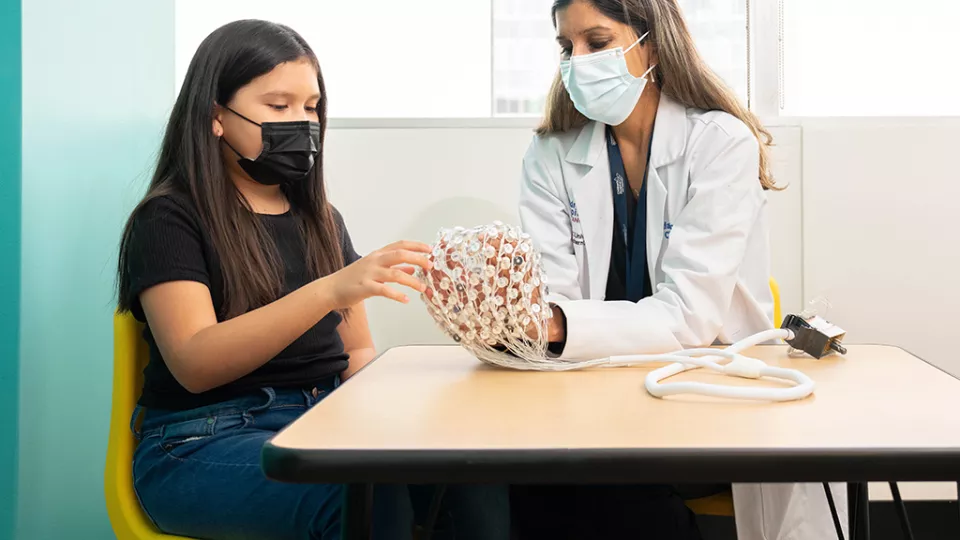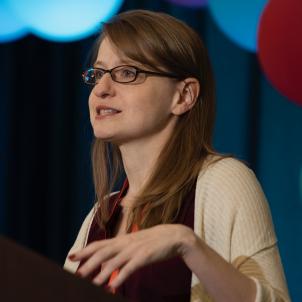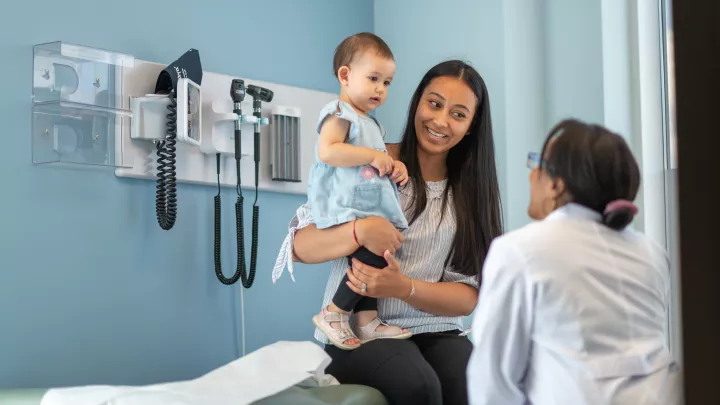
Shafali Spurling Jeste, MD, shows an EEG cap to a child.
Children’s Hospital Los Angeles Leads First Precision Health Trial for Dup15q Syndrome
Children’s Hospital Los Angeles has launched a new clinical trial to investigate a potential treatment for Dup15q syndrome, a rare genetic condition that causes developmental delays, autism spectrum disorder and epilepsy.
Called Quindecim, the randomized controlled trial is the first precision health clinical trial in the disorder and incorporates a biomarker and endpoints established by a research team at Children’s Hospital Los Angeles: neurologist Shafali Spurling Jeste, MD, and clinical psychologist Charlotte DiStefano, PhD.
The international study—which aims to enroll 90 children ages 2-11 and is sponsored by a pharmaceutical company—opened in August at CHLA, the lead site, and will include 10 centers across the country, as well as several sites in Europe.
“Currently we have treatments for epilepsy and certain behavioral issues, but we don’t have treatments specific to Dup15q syndrome,” says Dr. Jeste, Chief of Neurology, Co-Director of the Neurological Institute and Las Madrinas Chair at Children’s Hospital Los Angeles. “The goal with this study is to evaluate a potential therapeutic that would be targeted to the cause of these core symptoms.”
An eight-year journey
The team first became interested in a Dup15q biomarker nearly 10 years ago, after reading an intriguing finding buried in a published case series.
The paper noted that patients with the disorder had a unique electroencephalography (EEG) brain wave pattern that made it look like they were taking medications—such as benzodiazepines—that increase a neurotransmitter called GABA in the brain. But the patients weren’t taking these drugs.

Photo courtesy of Dup15q Alliance
“It’s rare to see something that distinctive, and we wondered if this EEG pattern could be a potential biomarker for this genetic condition,” Dr. Jeste explains. “That led us on an eight-year journey to quantify the biomarker and study this population, so if a therapeutic was developed, we would be ready for a clinical trial.”
To compile data, she and Dr. DiStefano began attending annual conferences of the Dup15q Alliance, a patient advocacy group. The conferences often include an international family meeting as well as scientific sessions.
The researchers literally set up in the hallway of the conference hotel, with Dr. Jeste gathering EEG data on children and Dr. DiStefano performing behavioral and cognitive assessments in a nearby hotel room.
Over the years, they collected data on approximately 100 children—creating the largest dataset of prospectively collected information on children with Dup15q.
“The families we have met are amazing. They are so dedicated and so eager to be involved in research,” says Dr. DiStefano, a lead investigator in the trial and Lead Psychologist for Autism and Neurodevelopmental Services at Children’s Hospital Los Angeles. “They are a big part of what moved this project forward.”
Measuring GABA activity
Three years ago, Dr. Jeste began working with Roche Pharmaceuticals to help design a clinical trial to test a drug called basmisanil—which the company was studying in other conditions—in Dup15q syndrome.
Dup15q is caused by having an extra copy of a piece of chromosome 15. That particular region has many genes that are important for brain development, including many GABA receptor genes.
“Because those GABA receptor genes are duplicated in these children, those genes are over-expressed, and that may lead to altered, possibly excessive, GABA signaling in the brain,” explains Dr. Jeste, a lead investigator in the trial.
The drug is a GABA receptor antagonist—basically, a substance that aims to reduce GABA activity in the brain. The biomarker Dr. Jeste and Dr. DiStefano researched helps measure GABA in the brain.
Trial participants receive an EEG at the start of the trial, as well as a second EEG after they have received the drug. “We want to see if that EEG changes right away,” Dr. Jeste says. “That’s going to be the measure of whether the drug is hitting that specific pathway.”
The importance of precision health
The phase 2 trial is also incorporating clinical endpoints based on the team’s research. While researchers will be looking to see if the drug changes EEG patterns, the primary endpoint is to see what effect, if any, the drug has on a child’s daily living skills. These skills will be measured by the Vineland Adaptive Behavior Scales.
“One of the challenging aspects of this condition is that it causes a large range of impairments, from mild to very severe,” Dr. DiStefano notes. “Our data showed that the Vineland does a good job of measuring skills across this range in children with Dup15q.”
Children will be followed for one year, and participants will be randomized into two groups: Two-thirds will receive the active drug, while one-third will receive a placebo.
Dr. Jeste—who is also a site principal investigator in a National Institutes of Health-sponsored consortium evaluating biomarkers in autism—adds that these kinds of precision health trials will become increasingly common in neurodevelopmental disorders.
“The biomarker in Dup15q syndrome is quite exceptional because it’s so prominent,” she says. “But there are so many therapeutics being developed right now for neurodevelopmental disorders. We hope that biomarkers can help determine not only whether drugs are hitting a target, but also which subgroups of children may benefit from specific types of therapeutics. This level of precision is the next necessary step in our field.”


